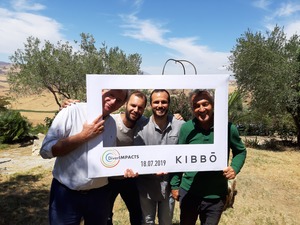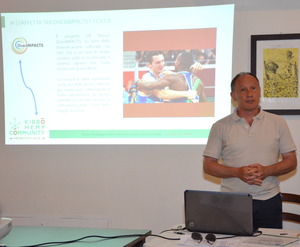Case study 9: Italy: Diversification of durum wheat cropping systems in semi-arid environment with sulla clover, hemp and chickpea
Cluster 2: Crop diversification under adverse conditions
A key objective of the case study is to identify suitable pathways for innovative agronomic solutions and value chain options in a harsh agro-climatic context offering a narrow spectrum of alternatives in terms of crop diversification. The case study originates from the need to diversify durum wheat-based arable systems in dry and rainfed conditions in Sicily. As monocropping and large wheat extensions have frequently characterised the Sicilian landscape, the use of leguminous crops in rotation has often represented the most common choice to break monocultures. Testing options for sulla clover or chickpea cultivation in rotations with durum wheat in Sicily was thus one of the preliminary ideas of the case study. Later on, developments at the regulatory and market levels opened up opportunities for hemp-based food chains and the crop was integrated in the case study farms’ rotations and economic strategies.



What were the main problems underlying the emergence of the case study?
Coping strategies for climate and economic variability were needed by case study actors. They were experiencing loss of soil fertility and erosion as well as income instability.
In Sicily, crop diversification beyond the usual crops is hampered by the semi-arid conditions with inconsistent rainfall, scarce irrigation facilities and water accessibility, unsuitable or non-profitable alternative markets, and lack of competences and technical advice on agroecological solutions. The identification of suitable pathways for innovative agronomic solutions and value chain options in the Sicilian context thus was and still is urgent. Notably, Sicily is the region with the largest organic acreage and number of farms in Italy, presenting opportunities for the upscaling of a more favourable sociotechnical environment.
Value chain diversification is hindered by barriers acting at multiple levels: environmental (the semi-arid condition constrains diversification options), socio-economic (market rigidity and lack of cooperation among producers) and cognitive (resistance to exploring agronomic and marketing alternatives). However, the sociocultural lock-ins do not seem insurmountable; the case study actors already see promising dynamics in niche and innovative areas such as rediscovery of local/ancient grains, innovative hemp value chains for local-to-European markets, and options arising from circular economy opportunities.
How was the problem addressed and which actors were involved?
Starting from informal gatherings of assorted actors, a ‘Sulla Club’ was established to determine to what extent sulla clover could represent a valid agronomic and economic option in Sicily, including its suitability for biogas production and digestate use for soil fertility and carbon storage. The ‘Sulla Club’ pooled together various actors in the value chain (farmers, breeders, millers and researchers) to discuss emerging issues in Sicilian arable crops.
Subsequent stakeholder engagement carried out by the case study in its initial phases identified further crop diversification possibilities, which introduced hemp in the rotation. This was triggered by a legislative evolution in Italy, which removed legal obstacles in the cultivation, transformation and sale of hemp and hemp-derived/hemp-based products. Consequently, two additional farms joined the case study group bringing in pioneering expertise on hemp.
The case study core group thus emerged with the participation of two research institutions (FIRAB and CREA) and four Sicilian farms (conventional, organic and transitioning to organic) with heterogeneous farm organisations, crop rotations, pedoclimatic conditions and reference value chains.
Solution investigated
Considering this diversity in pedoclimatic environments, management and marketing options, the case study mainly investigated:
- organisational and agronomic solutions at the farm level;
- technical and market options for durum wheat, which is a key crop in the regional arable sector;
- pertinent value chain trajectories for other key crops in the rotations.
The case study has partially redirected its focus. While agronomic options to increase durum wheat sustainability remained one of its driving foci, the case study increasingly explored the socio-technical determinants for introducing hemp in rotation.
This was due to two combined factors: on one hand, the original idea to leverage leguminous crops such as sulla clover or chickpea suffered due to a deteriorated market (local and national) for the two crops. Their prices dropped and they were no longer seen as promising additions to a rotation. On the other hand, hemp proved to be a valid economic option in the short-to-medium term, playing a positive role in rotations, too, as shown by the case study farms sustainability performance assessment.
To explore the enabling conditions for the adoption of more innovative agroecological and marketing options, the case study has engaged a plethora of stakeholders (farmers and farmers’ organisations, processors, researchers and regional authorities) to discuss options for crop and market diversification, mostly revolving around the potential of hemp value chains, considering the fast-growing interest in the crop and its many possible uses in the region.
A market investigation, carried out in collaboration with work package 5 (See below: Exploring the potential of value chains for Sicilian hemp-based food products), analysed barriers and enablers for hemp-based value chains and provided valuable information for the case study farmers and stakeholders on hemp-based food marketing and scalability. This investigation was followed up by a study on co-marketing options and formal and informal organisational arrangements among hemp growers, leveraging dedicated analyses of the nutritional quality of Sicilian hemp oils and flours, and making use of the seed money opportunity.
The investigated solutions of the hempseed oil potential at the farm and downstream levels, including the related barriers to development, are more analytically discussed in a paper published in the Oilseeds and fats Crops and Lipids Journal (See below: An action-research exploration of value chain development from field to consumer based on organic hempseed oil in Sicily).
Expected outcome
Determining the effectiveness and scalability of crop diversification options in semi-arid contexts was among the desired effects of the case study plan. The case study strategy was designed to identify priority areas for targeted actions intended to enable both further research findings and concrete strategies for practitioners. To this aim, the initial exploration of barriers to hemp development confirmed that they occur at different levels: the multi-stakeholder case study initiatives at the farming, processing and governance scales proved to be conducive to a development plan aiming to reorient farms’ market choices towards locally constructed value chains, considering the reduction in market interest in more traditional crops.
The ultimate case study goal is to provide viable transition pathways that regional and national stakeholders and policy makers may consider in their quest to achieve more sustainability in farming under severe climatic conditions.
Relevance to the DiverIMPACTS goals
How to combine crop diversification with market diversification and consumers interest in novel foods is one of the most significant contributions the case study makes to DiverIMPACTS.
Case study legacy
The case study generated the enabling conditions for setting up two EIP-AGRI Operational Groups on hemp-based food chains whose overall partnerships pool together a dozen farms and value chain operators, as well as three research organisations. The two operational groups include all of the case study 9 actors and scientific institutions, with the exception of one farm that has no stake in the crop.
Agroecological approaches for hemp cultivation, options for processing to achieve the highest possible quality and nutritional properties as well as economic explorations will represent the key innovation areas being developed by the operational group until 2024, thus providing continuity and operationalisation of the DiverIMPACTS investigations.
Further information
Links
- ansa.it: In Sicilia il Rinascimento rurale passa dalla canapa
- zenodo.org: An Actor-Oriented Multi-Criteria Assessment Framework to Support a Transition towards Sustainable Agricultural Systems Based on Crop Diversification
- zenodo.org: Big cannabis e cannabis picciotta
- zenodo.org: Exploring the potential of value chains for Sicilian hemp-based food products
- zenodo.org: An action-research exploration of value chain development from field to consumer based on organic hempseed oil in Sicily
- zenodo.org: Reintroduzione della coltivazione della canapa nelle zone mediterranee
- zenodo.org: Reintroducing hemp cultivation in Mediterranean areas
Case study team
- Luca Colombo, FIRAB, case study leader
- Giovanni Dara Guccione, case study monitor
 tap and then scroll down to the Add to Home Screen command.
tap and then scroll down to the Add to Home Screen command.